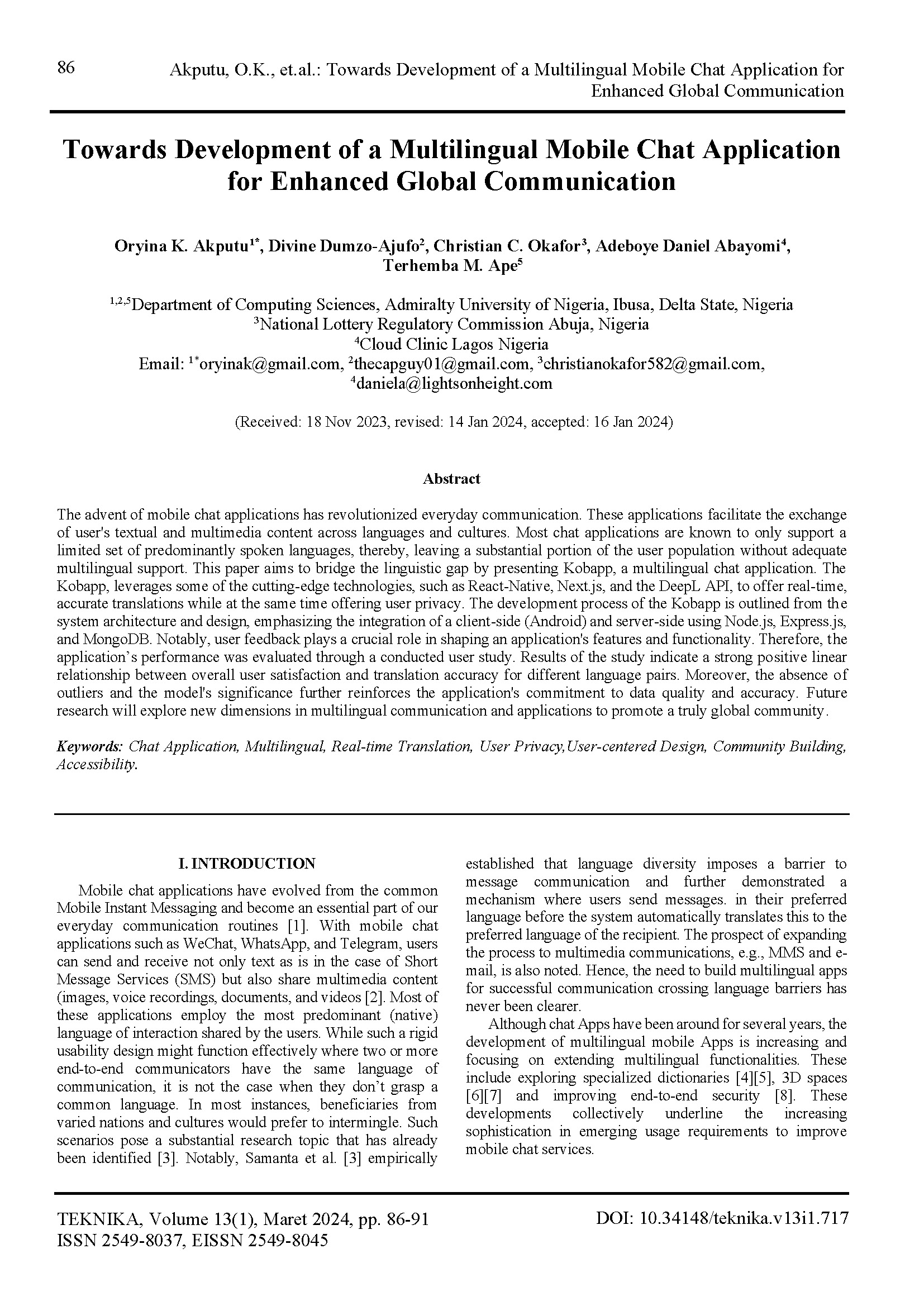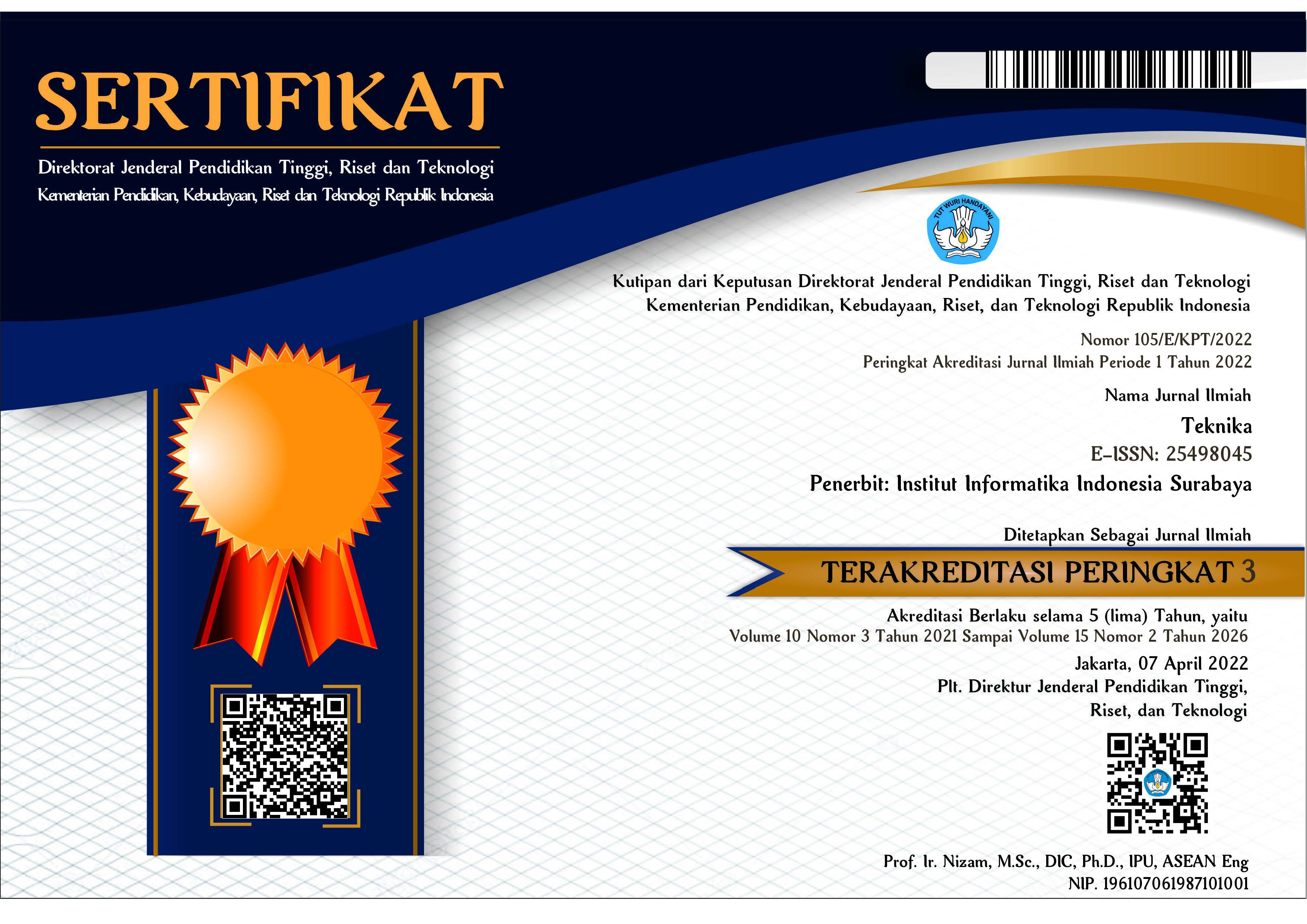Towards Development of a Multilingual Mobile Chat Application for Enhanced Global Communication
DOI:
https://doi.org/10.34148/teknika.v13i1.717Keywords:
Chat Application, Multilingual, Real-time Translation, User Privacy, User-centered Design, Community Building, AccessibilityAbstract
The advent of mobile chat applications has revolutionized everyday communication. These applications facilitate the exchange of user's textual and multimedia content across languages and cultures. Most chat applications are known to only support a limited set of predominantly spoken languages, thereby, leaving a substantial portion of the user population without adequate multilingual support. This paper aims to bridge the linguistic gap by presenting Kobapp, a multilingual chat application. The Kobapp, leverages some of the cutting-edge technologies, such as React-Native, Next.js, and the DeepL API, to offer real-time, accurate translations while at the same time offering user privacy. The development process of the Kobapp is outlined from the system architecture and design, emphasizing the integration of a client-side (Android) and server-side using Node.js, Express.js, and MongoDB. Notably, user feedback plays a crucial role in shaping an application's features and functionality. Therefore, the application’s performance was evaluated through a conducted user study. Results of the study indicate a strong positive linear relationship between overall user satisfaction and translation accuracy for different language pairs. Moreover, the absence of outliers and the model's significance further reinforces the application's commitment to data quality and accuracy. Future research will explore new dimensions in multilingual communication and applications to promote a truly global community.
Downloads
References
Y. Tang & K.F. Hew, “Is mobile instant messaging (MIM) useful in education? Examining its technological, pedagogical, and social affordances,” Educational Research Review, 21, 85—104, 2017. https://doi.org/10.1016/J.EDUREV.2017.05.001
K. Church & R. De Oliveira, “What’s up with WhatsApp? Comparing mobile instant messaging behaviors with traditional SMS,” MobileHCI 2013 - Proceedings of the 15th International Conference on Human-Computer Interaction with Mobile Devices and Services, 352—361, 2013. https://doi.org/10.1145/2493190.2493225
S.K. Samanta, J. Woods & M. Ghanbari, “Automatic language translation: An enhancement to the mobile messaging services,” International Journal of Technology and Human Interaction, 7(1), 1—18, 2011. https://doi.org/10.4018/jthi.2011010101
M. Nakano & K. Komatani, “A framework for building closed-domain chat dialogue systems,” Knowledge-Based Systems, 204, 106212, 2020. https://doi.org/10.1016/J.KNOSYS.2020.106212
M. Nakatsuka, S. Yasunaga & K. Kuwabara, “Extending a multilingual chat application: Towards collaborative language resource building,” Proceedings of the 9th IEEE International Conference on Cognitive Informatics, ICCI 2010, 137—142, 2010. https://doi.org/10.1109/COGINF.2010.5599751
A.S. Dhanjal & W. Singh, “An automatic machine translation system for multi-lingual speech to Indian sign language,” Multimedia Tools and Applications, 81(3), 4283—4321, 2022. https://doi.org/10.1007/S11042-021-11706-1/METRICS
T. Yoshino & K. Ikenobu, “Availability of multilingual chat communication in 3D online virtual space,” Lecture Notes in Computer Science (Including Subseries Lecture Notes in Artificial Intelligence and Lecture Notes in Bioinformatics), 6259 LNCS, 28—40, 2010. https://doi.org/10.1007/978-3-642-17184-0_3/COVER.
R.N. Akram & R.K.L. Ko, “End-to-end secure and privacy preserving mobile chat application,” Lecture Notes in Computer Science (Including Subseries Lecture Notes in Artificial Intelligence and Lecture Notes in Bioinformatics), 8501 LNCS, 124—139, 2014. https://doi.org/10.1007/978-3-662-43826-8_9/COVER
S. Căpuşneanu, M.T. Fülöp, D.I.Topor, N.M. Iacob, A.G. Solomon & A.M. Ifrim, “Designing a Mobile Chat Application Based on Android Platform,” International Journal of Innovation in the Digital Economy, 12(4), 43—63, 2021. https://doi.org/10.4018/IJIDE.2021100104:
P. Kandpal, K. Jasnani, R. Raut & S. Bhorge, “Contextual chatbot for healthcare purposes (using deep learning),” Proceedings of the World Conference on Smart Trends in Systems, Security and Sustainability, WS4 2020, 625—634, 2020. https://doi.org/10.1109/WORLDS450073.2020.9210351
K.A. Nugraha, Restyandito, D. Sebastian & N.C. Wijaya, “Designing Mobile-based Chat Application for Elderly,” 2022 2nd International Conference on Intelligent Cybernetics Technology and Applications, ICICyTA 2022, 29—34, 2022. https://doi.org/10.1109/ICICYTA57421.2022.10037811
S. Shukla, S.C. Gupta & P. Mishra, “Android-Based Chat Application Using Firebase,” 2021 International Conference on Computer Communication and Informatics, 2021. https://doi.org/10.1109/ICCCI50826.2021.9402510
M. Nakano & K. Komatani, “A framework for building closed-domain chat dialogue systems,” Knowledge-Based Systems, 204, 106212, 2020. https://doi.org/10.1016/J.KNOSYS.2020.106212
K. Ralston, Y. Chen, H. Isah & F. Zulkernine, “A voice interactive multilingual student support system using IBM watson,” Proceedings - 18th IEEE International Conference on Machine Learning and Applications, ICMLA 2019, 1924—1929, 2019. https://doi.org/10.1109/ICMLA.2019.00309
M. Carisi, A. Albarelli & F.L. Luccio, “Design and implementation of an airport chatbot,” ACM International Conference Proceeding Series, 49—54, 2019. https://doi.org/10.1145/3342428.3342664
K. Kadam, S. Godbole, D. Joijode, S. Karoshi, P. Jadhav & S. Shilaskar, “Multilingual Information Retrieval Chatbot,” Studies in Computational Intelligence, 1027, 107—121, 2022. https://doi.org/10.1007/978-3-030-96634-8_10/COVER
S. Singh & H.K. Thakur, “Survey of Various AI Chatbots Based on Technology Used,” 8th International Conference on Reliability, Infocom Technologies and Optimization (Trends and Future Directions) (ICRITO). 1074—1079, 2020.
J. Cai, J. Li, W. Li & J. Wang, “Deeplearning Model Used in Text Classification,” 2018 15th International Computer Conference on Wavelet Active Media Technology and Information Processing, ICCWAMTIP 2018, 123—126, 2019. https://doi.org/10.1109/ICCWAMTIP.2018.8632592
P. He, C. Meister & Z. Su, “Structure-invariant testing for machine translation,” Proceedings - International Conference on Software Engineering, 961—973, 2020. https://doi.org/10.1145/3377811.3380339
F. Calefato, F. Lanubile, R. Prikladnicki & J.H.S. Pinto, “An empirical simulation-based study of real-time speech translation for multilingual global project teams,” International Symposium on Empirical Software Engineering and Measurement, 2014. https://doi.org/10.1145/2652524.2652537























